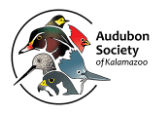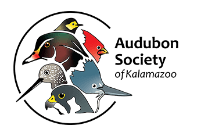Late 2009 – 2010
A Peregrine Falcon was seen on a regular basis near the fifteen story Fifth Third Bank building in downtown Kalamazoo. Two peregrine falcons – an unbanded male and a female identified as Idelle – attempted to nest on a high ledge of the bank building.
2011
A pair of peregrine falcons – presumably the same male and a different female, Rebecca – mated near a drain on a high ledge and laid three eggs which were washed away by heavy rains.
2012
DNR Wildlife Biologist, Mark Mills, installed a nest box on top of the bank. The birds used the same drain as a nest again, losing their eggs in the process. This nest box was subsequently taken down.
2013
Fifth Third Bank officials, Mark Mills, and the ASK selected a better location for a nest box, which was installed with the help of Nehil – Sivak Consulting Structural Engineers and Building Restoration, Inc. Unfortunately, the birds had already unsuccessfully chosen the same drain as a nest.
2014
The peregrine pair again spent the winter in the area, and it was hoped they would acclimate to the box and accept it. To everyone’s pleasure, they did. Based on several photographs of the four chicks as they become active at the box entrance, the hatch date was estimated to be May 14-15. Counting back for an average incubation period of 30 days, the egg lying date was estimated to be April 15-16. One of these young birds was banded while in rehab and named Promise. Another bird died from a window collision at Bronson Hospital.
2015
The pair of Peregrine Falcons remained in Kalamazoo for the winter. Thanks to generous support from Zoetis, two cameras and a microphone were installed in January. We then saw that there was a new banded male. Kewpee was hatched in Lima Ohio in 2010. Four chicks were hatched between May 4 and May 5: two females (Kazoomi and Athena), and two males (Gibson and Birdick). The birds fledged between June 11 and June 14th.
2016
Four chicks were hatched between April 26 and April 28: two females (Breeze and Arcadia), and two males (Checker and Strong). The birds fledged the nest between May 31 and June 8, with the smallest, Checker, requiring rehab after an early fledge.
2017
Three chicks hatched (with one egg that did not hatch) between April 25 and 26: a male (Sharib, aka Bentley), and a female (Apex) who required rehab after a collision on the mall. A second, unnamed male was an early fledge who went to rehab and later died from a window collision at the WMU Med School.
2018
Four chicks hatched between April 24 and April 26: a male (Jeter), and three females (Merze, Iris, and Zoe). The birds fledged between June 3 and June 14. Jeter fledged early and was fatally hit by a car. Merze died near Senior Services as the young birds were starting to range further and leave the territory for their next adventures.
2019
Three chicks hatched (one egg did not hatch) between April 30 and May 2: three males (Abe, who fledged on June 8; Frank, who fledged on June 9; and Stryker, who fledged on June 7. Frank stayed in the territory for a long period of time.
2020
Due to the difficulties presented by the COVID-19 virus, the four birds who hatched between April 24 and April 28, were not banded. All four birds fledged between June 5 and June 7, with two early fledges needing rehab.
2021
Four chicks were hatched between April 28 and May 1: three males (Vincent, Chase, and Skye), and one female (Princess). Chase, Princess, and Skye all required rehab. Skye was grounded again after returning home and was kidnapped on June 17. After additional rehab for a concussion, Skye returned to the nest on July 13.
2022
Three chicks were hatched between April 30 and May 4: two males (Alex and Enoch), and a female (Victoria). Victoria died in late July while under anesthesia following repair of a broken wrist. Enoch required rehab after an early fledge.
2023
Four chicks were hatched between April 25 and April 28: two females (Winerva and Artemis), and two males (Zeus and Hermes). They were all grounded on their first flights and spent some time in rehab before returning home Artemis was spotted several times at the Muskegon Wastewater Facility in the fall.
2024
A new nest box was installed in the same location in Fall 2023. Rebecca and Kewpee accepted the new box, and four eggs were laid between March 18 and 25. Only two of the eggs hatched with one female (Stella) and one male (Soar). Both were grounded on their first flights and went to rehab for a short time. Stella sadly was killed when she flew into a window after returning to Kalamazoo.


